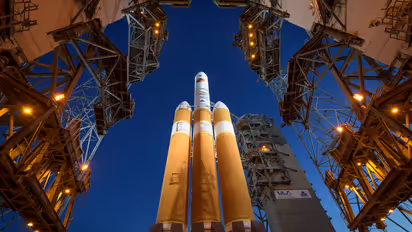Opinion | Touching the Sun: Parker Solar Probe's historic journey; will it uncover long-standing mysteries?

Synopsis
The Parker Solar Probe is on a historic mission to make the closest-ever approach to the Sun, exploring its outer atmosphere and uncovering mysteries about solar wind and the corona.
A NASA spacecraft is on a mission to achieve a historic milestone by making the closest approach to the Sun ever attempted. The Parker Solar Probe is diving into the Sun's outer atmosphere, facing intense heat and harsh radiation.
During this scorching fly-by, the Parker Solar Probe will lose contact with Earth for at least three days. Scientists are eagerly waiting to receive a signal on December 27 to confirm if it has made it through safely.
The goal is for the probe to help us learn more about how the Sun operates.
Dr. Nicola Fox, NASA's head of science, explained to BBC News, "People have studied the Sun for centuries, but you can’t truly understand its atmosphere until you go there and experience it directly."
We can’t truly understand the Sun’s atmosphere unless we actually fly through it.
The Parker Solar Probe, launched in 2018, is on a mission to explore the heart of our Solar System (Sun)
The Parker Solar Probe has already flown past the Sun 21 times, getting closer each time, but its Christmas Eve (24th December) approach sets a new record.
During its closest approach, the probe comes within 3.8 million miles (6.2 million kilometers) of the Sun’s surface. To put this in perspective, the Sun is about 150 million kilometers away from Earth, so the probe is getting incredibly close compared to the usual distance.
It might not seem very close, but NASA's Nicola Fox explains it this way: "The Earth is about 150 million kilometers away from the Sun. If we imagine the distance between the Sun and Earth as one meter ( 100 cms ) the Parker Solar Probe would be just four centimeters away from the Sun—now that’s close!"
The probe will face scorching temperatures of 1,400°C and intense radiation that could damage its onboard electronics.
The spacecraft is protected by a 11.5 cm (4.5-inch) thick carbon shield, and its main plan is to fly in and out quickly.
The probe will travel faster than any object made by humans, reaching an incredible speed of 692,000 kilometers per hour. To help understand, this is like flying from London to New York in less than 30 seconds!
Also read: Opinion: Why's Haqqani Network Parting Ways with the Taliban Regime?
Why put in so much effort to get close to the Sun?
Scientists are hopeful that as the spacecraft travels through the outer layer of the Sun, known as the corona, it will help uncover answers to a long-standing mystery.
"The corona is extremely hot, and we don’t really know why," says Dr. Jenifer Millard, an astronomer at Fifth Star Labs.
The Sun’s surface is around 6,000°C, but its outer atmosphere, called the corona, which you can see during a solar eclipse, gets much hotter—reaching millions of degrees. But the strange part is that the corona is farther away from the Sun’s surface. So, how does it get hotter?
The mission will also help scientists learn more about the solar wind—a steady flow of charged particles that comes from the Sun’s outer atmosphere, the corona.
When these particles collide with the Earth’s magnetic field, they create stunning light displays in the sky called auroras (bright, colorful lights that appear near the poles).
Earth's magnetic field is caused by the movement of molten iron in its outer core. This motion generates electric currents, which produce the magnetic field surrounding our planet.
However, this "space weather" can also cause issues, such as disrupting power grids, damaging electronics, and interfering with communication systems.
Dr. Millard explains that studying the Sun, its behavior, space weather, and solar wind is essential because it affects our daily lives on Earth.
NASA scientists will spend Christmas anxiously waiting while the spacecraft is out of contact with Earth.
Nicola Fox shared that as soon as the probe sends a signal back to Earth, the team will text her a green heart to confirm that it’s safe.
She admits feeling nervous about this daring mission but trusts the probe completely.
"I do worry about the spacecraft, but it’s built to handle these extreme, harsh conditions. It’s a strong and resilient little spacecraft," she said.
(The author of this article is a Defence, Aerospace & Political Analyst based in Bengaluru. He is also Director of ADD Engineering Components, India, Pvt. Ltd, a subsidiary of ADD Engineering GmbH, Germany. You can reach him at: girishlinganna@gmail.com)
Check the Breaking News Today and Latest News from across India and around the world. Stay updated with the latest World News and global developments from politics to economy and current affairs. Get in-depth coverage of China News, Europe News, Pakistan News, and South Asia News, along with top headlines from the UK and US. Follow expert analysis, international trends, and breaking updates from around the globe. Download the Asianet News Official App from the Android Play Store and iPhone App Store for accurate and timely news updates anytime, anywhere.